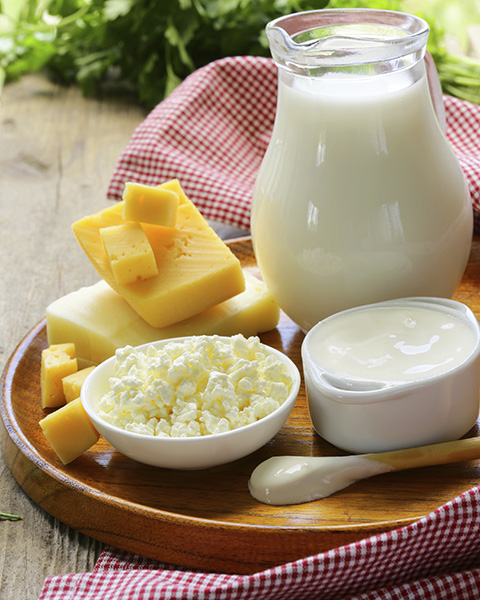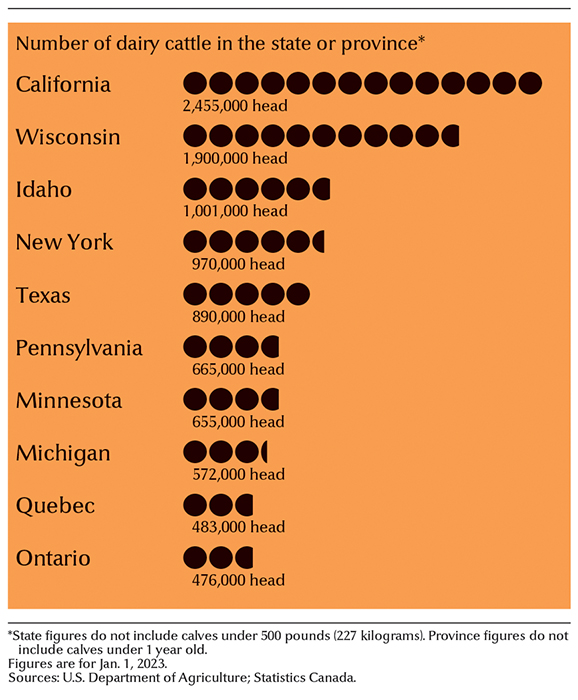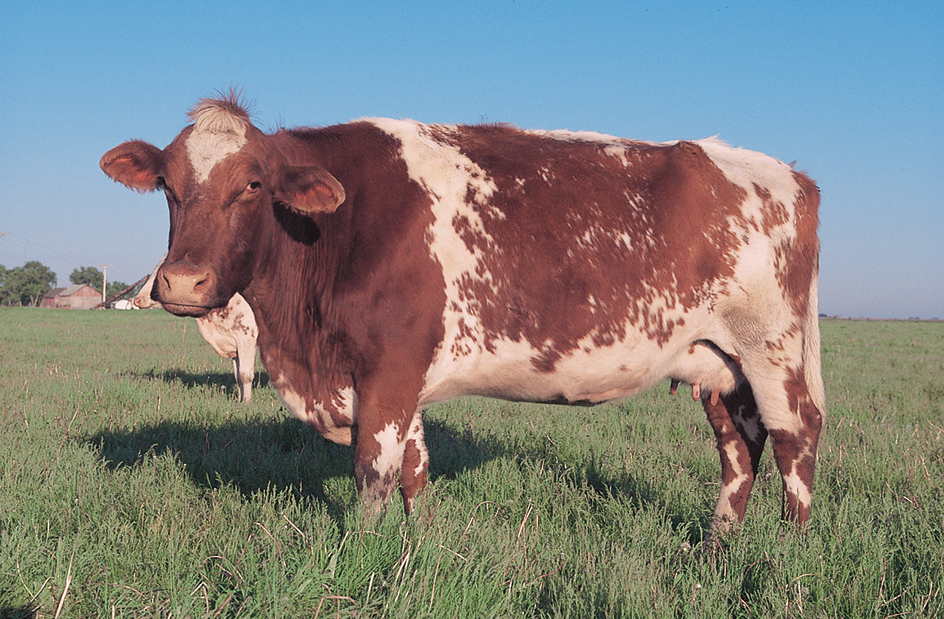Dairying is the branch of agriculture concerned with the production of milk, butter, evaporated milk, ice cream, cheese, and dried milk products. It includes the care and feeding of the animals that produce the milk. Dairies operate in most countries. Denmark, France, Italy, Switzerland, and the United States are among the countries that are famous for their dairy products.

Although cattle produce about 80 percent of the world’s milk supply, other animals are important to dairying in many countries. In France, Greece, Italy, and the United States, sheep’s milk is used to make certain cheeses. Goats are also an important dairy animal, particularly in some less developed countries. Many people in the Middle East drink camel’s milk. The Sami, a people of far northern Europe, drink reindeer milk. The people of China, Egypt, and India are among those who use the milk of water buffalo. This article discusses primarily dairy cattle.

There are about 270 million dairy cows throughout the world. They produce about 190 billion gallons (720 billion liters) of milk each year. Milk yields vary widely in different parts of the world. In the United States, for example, the average annual milk yield per cow is about 2,700 gallons (10,200 liters). In Africa, it is only about 150 gallons (570 liters).
Dairy farming
Almost every country has a dairy farming industry, but dairy farming is most highly organized and concentrated in industrialized countries. A large commercial dairy farm may have more than 1,000 cows. Industrialized countries produce more than half of the total supply of dairy products. Most less developed countries cannot supply their own milk needs. In some less developed countries, the people may consume an average of only about 1 gallon (4 liters) of fluid milk per year. In contrast, the people of many developed countries consume an average of more than 20 gallons (76 liters) of fluid milk per year.

In industrialized countries, the amount of milk produced typically exceeds the demand. Many of these countries use surplus milk in school or food aid programs, donate it to special groups, feed it to livestock, or export it. Many less developed countries import milk at low cost, or entirely free, from industrialized countries. Some organizations help less developed nations become more self-sufficient in milk production.
India leads all countries in milk production. Other major milk-producing countries include Brazil, China, Germany, Pakistan, and the United States. In the United States, every state has dairy farms. The dairy industry is concentrated in a group of states in the East and Midwest, from New York to Minnesota. But the industry is growing rapidly in California and other Western States. California is the leading milk-producing state, followed by Wisconsin.
Dairy cattle.
The most important breeds of dairy cattle are the Ayrshire, Brown Swiss, Guernsey, Holstein (called Holstein-Friesian in some parts of the world), Jersey, and Milking Shorthorn. Originally bred in Europe and developed in the United States, these breeds have been introduced into dairy herds around the world. The breeds vary in size and color. Ayrshires are deep red, brown, or a combination of these colors with white. Brown Swiss are solid brown, and Guernseys are pale fawn or fawn and white. Holsteins are black and white. Jerseys are fawn to brown, with or without white markings. Milking Shorthorns are red, white, or roan (a mixture of red and white). The Holstein is generally the largest breed. The average weight of a mature Holstein is about 1,500 pounds (680 kilograms). The Jersey, at 1,000 pounds (450 kilograms), is the smallest breed.

The breeds can be distinguished by the composition of their milk and the amount they produce. A dairy farmer chooses breeds of cattle based on personal preference and on the type of market for the milk. For example, a farmer supplying milk for cheesemaking might choose a breed that produces milk with a higher fat content than would a farmer supplying milk for drinking. Holsteins are popular because they produce a high volume of milk. Jerseys are popular as well because of the richness of their milk, which has 5 percent butterfat (the natural fat in milk) and a high protein content. Jerseys also tolerate heat better than other breeds.
Loading the player...Why do we get our milk from cows?
Dairy cattle whose ancestry can be traced to the original animals of a breed are called purebred. A registered animal is one whose ancestry has been recorded with a breed association. Most dairy cattle are not registered with a breed association. Such cattle are often called grade cows. Many grade cows are born of unregistered cows and registered purebred bulls.
Milking.
Dairy farmers usually milk their cows at regular times, once each morning and once each evening at about 12-hour intervals. Some farmers prefer to milk their cows three times a day. This practice tends to increase a cow’s daily milk production by 10 percent or more. Most dairy farmers milk their cows by machine in a room called a milking parlor. The machines attach to the cows’ teats and draw the milk directly from the cow. The milk flows through a stainless steel pipeline into a milk room separate from the milking parlor. This system keeps the milk clean. The milk room has vats for washing equipment and a tank where the milk is cooled and stored until the farmer can ship it.

How much milk do cows produce?
Most top-grade fluid milk comes from dairy farms that meet strict quality codes and standards. Milkers carefully clean and disinfect the cows’ teats to remove impurities and bacteria before milking. After they are finished milking, the milkers wash and sanitize all equipment, including the pipe through which the milk runs into the milk house. They also wash the milking parlor.
Housing.
There are three main types of housing systems for dairy cattle: (1) stanchion housing,2) loose housing, and (3) free-stall housing. In stanchion housing—also called tie-stall housing—farmers keep their cows in individual stalls at all times, except for milking and brief exercise periods. One end of a short chain is attached to a strap or light chain around the cow’s neck, and the other end connects to a metal rail. The chain is long enough to give the cow room to move and to lie down comfortably. In the stanchion system, the cows have separate drinking cups and feed mangers. A gutter runs behind the stalls to collect manure and urine. Many gutters are equipped with mechanical devices called barn cleaners. A barn cleaner is a motor-driven chain with paddles that pull the manure into a manure spreader or holding area. The spreader is used to scatter manure onto the land to make the soil more fertile.
In loose-housing—also called pen housing—cows are free to move around as they please. In warm weather, they may go out to the pasture between milkings. In cold weather, they may rest in a loafing barn, a large shed that is open on one side.
Farms that do not have a loafing barn usually have free-stall barns with rows of individual stalls that allow the cows to enter and leave at any time to eat, drink, or exercise. Modern free-stall barns are designed to make the cows as comfortable as possible. Stall surfaces include mattresses or sand. Many modern free-stall barns have retractable curtain side walls that can be opened to allow maximum natural ventilation or closed to protect the animals from the elements. Proper ventilation protects the health of the cows by reducing heat stress. 
Feeding.
A dairy cow may weigh up to 1,700 pounds (770 kilograms) and produce more than 6,000 gallons (22,700 liters) or more of milk during a year. High-producing animals eat large amounts of concentrates and forages. Concentrates are grains and by-product feeds. By-product feeds include corn gluten feed and meal, dried distiller’s grains, molasses, and wheat mill feeds. Forages consist of pasture (grasses, legumes, and other plants), hay, and silage (chopped plant stalks that have been stored in a silo). Farmers usually store hay in the barn loft or in a hay shed. Silage is stored in a silo, where it ferments. Most high-producing herds are fed in dry lots or barns, rather than put out to pasture. Workers bring the feed to the cows, which eat together from long mangers called feed bunks.
Cows that produce a large amount of milk need feed that provides energy, protein, and essential vitamins and minerals. Dairy farmers try to balance a cow’s ration and provide all food nutrients in the proper amounts and proportions. The total mixed ration (TMR) is a method in which all ingredients of the diet are blended together in the proper proportions prior to feeding. Typical energy feeds include barley, corn, grain sorghums, oats, and wheat. Cottonseed and soybean meal are typical protein feeds. Examples of forages that supply both protein and energy are alfalfa, clover, corn silage, mixed hays, sorghum silage, and many varieties of pasture.
Organic dairying.
To sell milk with an organic label, farmers must raise cows without the use of antibiotics or artificial growth hormones. The cows also must be given organic feed and access to pasture.
The economics of dairying.
Dairy farming requires large financial investments. In the United States, for example, many farmers invest hundreds of thousands of dollars for a small dairy farm. This investment includes the price of land, cattle, buildings, and equipment. Profits for dairy farmers are usually small, and the market price of milk fluctuates based on supply and demand. However, dairy farmers can make a good profit with high milk-yield per cow, efficient operation, and the use of labor-saving technology. In many countries, the government supports dairy farms.
Improvements in dairy farming.
Today’s dairy farmers have greatly increased milk production efficiency through improved methods of breeding, feeding, and management. Various organizations have contributed to the increased efficiency of dairy farming. In the United States, these organizations are the National Dairy Herd Information Association (DHIA), the United States Department of Agriculture (USDA), colleges of agriculture, and the Purebred Dairy Cattle Association. DHIA is a nonprofit, member-directed organization of dairy farmers. It employs trained supervisors to keep monthly milk, protein, and butterfat production records on association herds. The European Federation of Animal Science promotes efficient dairy farming practices in Europe. The Food and Agriculture Organization of the United Nations (FAO) plays an especially important role in improving dairy farming in less developed countries.
Most dairy cows are now bred by artificial insemination. Dairy farmers or artificial insemination technicians artificially inseminate cows by placing semen (sperm-containing fluid) from a donor bull in the reproductive organs of their fertile cows. The average bull used by an artificial insemination organization can be mated to over 3,000 cows a year. This method enables farmers to increase their use of outstanding purebred bulls to improve herd quality.
Dairy farming regulations
Many national, regional, and local governments have laws regulating the conditions under which dairy farmers can produce and sell milk. These laws are essential because of the many ways in which milk can become contaminated. The regulations demand the highest standard of cleanliness and hygiene and set up strict procedures for limiting the spread of diseases that can infect human beings through impure milk. All the containers that the milk passes through as it travels from the cow to the consumer must be clean, sterile, and dry. Farmers must remove cows with tuberculosis from their dairy herds. Farmers control the infectious disease brucellosis by testing their cattle, vaccinating the calves, and eliminating infected animals.
Most laws regulating dairies require that the operator have a license. In countries that exercise strict controls, dairy inspectors make sure that the farms meet sanitary regulations. The milk is tested to ensure that its composition meets the legal standard and that it contains no impurities. Regulators also ensure that organic milk is produced using the proper standards.
History of dairying
People of ancient Egypt, India, and other areas began using milk from cows and other animals thousands of years ago. By 3000 B.C., an organized dairy industry based on the milk of sheep and goats existed in Mesopotamia, a region that today covers parts of Iraq, Syria, and Turkey.
An important advance in dairying developed in the late 1600’s in North America, in colonial Massachusetts. Before that time, cows gave milk only during times of the year when they could feed in open pastures. Farm families used up what little milk the cows gave and had little to sell. Then, the colonists began feeding grain and hay to cattle during the winter. The cows gave milk all winter. This method of feeding cattle, called stall-feeding, made it possible to produce milk the year around. Pioneer families in the United States found that cattle manure could serve as a fertilizer. Many then purchased more cattle and sold the surplus milk.
For many years, farmers manufactured dairy products on the farm. As cities expanded, farms became farther and farther away from the city centers. It grew difficult to ship milk to consumers in the cities. The expansion of train systems in the mid-1800’s enabled farmers to ship milk to cities as far away as 50 miles (80 kilometers). As city markets increased, it became necessary to process milk on a larger scale. Today, the manufacture of milk products is highly industrialized in many parts of the world. But in other regions, dairy products are still made on farms.
